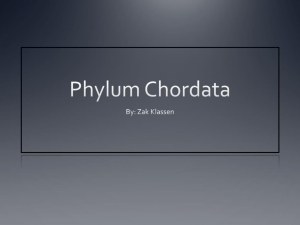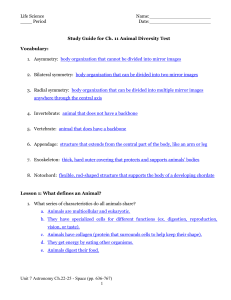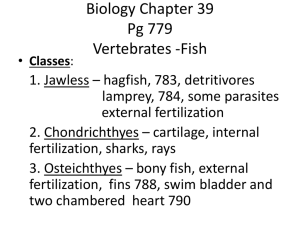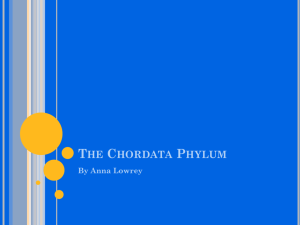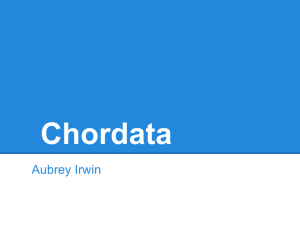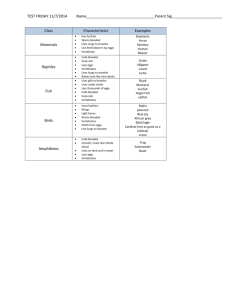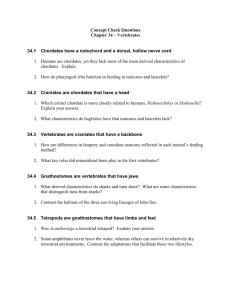Class Chondrichthyes
advertisement
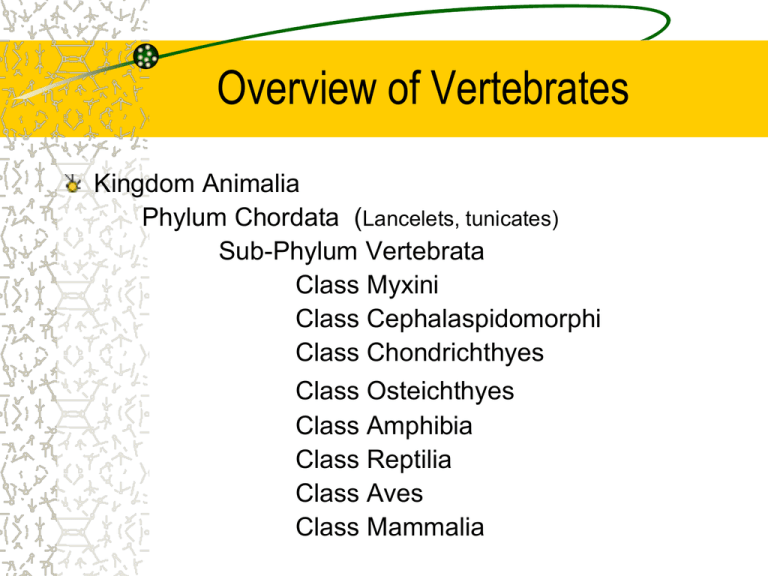
Overview of Vertebrates Kingdom Animalia Phylum Chordata (Lancelets, tunicates) Sub-Phylum Vertebrata Class Myxini Class Cephalaspidomorphi Class Chondrichthyes Class Osteichthyes Class Amphibia Class Reptilia Class Aves Class Mammalia Classes of Vertebrates Class Myxini Class Cephalaspidomorphi Class Chondrichthyes Class Osteichthyes Class Amphibia Class Reptilia Class Aves Class Mammalia Chordates At some point during development, members of this phylum MUST exhibit these characteristics: 1. Basic Characteristics: Notochord: develops into the skeleton 2. Pharyngeal Pouches (Gill slits): develops into gills in aquatic vertebrates; jaws/inner ear/nostrils in terrestrial vertebrates 3. Dorsal Nerve cord: develops into the spinal cord and brain 4. Post-anal tail: can contain bone and muscle 5. Ancestral thyroid gland: regulates metabolism, growth and development Page 803 Non-vertebrate Chordates 2 Sub-Phyla: Tunicates and Lancelets (aquatic) Tunicates (sea squirts): 1,250 species Lancelets: 23 species Fish Characteristics: Aquatic Vertebrates exhibit: 1. Paired fins 2. Scales 3. Gills (most) 4. 2 Chambered Heart: 1 atrium & 1 ventricle 5. Carnivores, herbivores, omnivores, parasites, filter feeders Lungfish Live in Australia, Africa, South America These areas have wet and dry seasons During dry season 1) They burrow into mud 2) Secrete slime that mixes with mud to create cocoon 3) Gulps air Fish Class Myxini and Cephalaspidomorphi: “Jawless Fish” - NO JAWS! Characteristics: 1. Eel shaped body 2. Cartilaginous skeleton 3. No fins or jaws 4. Filter Feeders/Parasites 5. Examples Myxini: Hagfish Cephalaspidomorphi: Lamprey Hagfish Lamprey Fish Class Chondrichthyes: “Cartilage Fish” Basic Characteristics: 1. Skeleton made of cartilage 2. Placoid scales 3. Jaws present 4. Examples: sharks, skates, rays Caribbean Reef Shark Great White caught off shore of Ragland, NZ Whale Shark Bull Shark Eagle Ray Blue Spotted Ray Skates Lay eggs in Mermaid’s purse Do not have barbed tails Only saltwater Rays Live birth Barbed tails Fresh and salt water Fish Class Osteichthyes: “Bony Fish” Basic Characteristics: 1. Skeleton made of bone 2. Skin with scales 3. Jaws present 4. Examples: Bass, Perch, Tuna….. Coelacanth Thought to be extinct for 70 million years Found near Comoro Islands (north of Madagascar) in 1938 Since then, fisherman occasionally catch them at great depths Can’t keep them alive more than a few hours after capture Class Amphibia 1. Basic Characteristics: Smooth, moist skin with NUMEROUS mucus glands 2. Gills, lungs – pulmonary respiration Skin - cutaneous respiration 3. Lacks scales and claws 4. Rely upon water for reproduction Metamorphosis: Larval stage – aquatic; Adult - terrestrial Larvae: 2 chambered heart Adults: 3 chambered heart 5. Examples: Salamanders, Toads, Frogs, Caecilians, Newt Coqui Bullfrog Newt salamander Caecilian Poison Dart Frog Frog External Anatomy: Tympanum – ear drum Nictitating membrane – protective eyelid Frog Internal Anatomy Cloaca – removal of waste and gametes Amphibian Reproduction Amphibians must lay their eggs in water since the eggs lack a protective outer membrane External fertilization and development for most amphibians. Metamorphosis Class Reptilia 1. 2. 3. 4. 5. 6. 7. Basic Characteristics: Dry, scaly skin Like Humans! Amniotic egg Internal fertilization Some with claws and limbs 3 chambered heart: 2 atria, 1 ventricle or 4 chambered heart (crocodiles and alligators) Ectothermic (cold-blooded) Respiration through lungs only Examples: snakes, lizards, tuatara, turtles, alligators Monitor lizard Milk snake Iguana Sea turtle Gecko Iguana Chameleon Crocodiles/Alligators: Eyes & nostrils are arranged on top of head allowing them to breathe and see Turtles: Shell parts - Carapace: dorsal; Plastron: ventral Reptiles Snakes: * Jacobson’s organ - detects food through scents * Infrared sensors in pit (pit vipers)- detect heat * Venom: 1) Hemotoxin (attack circulatory system) 2) Neurotoxin (attacks nervous system) * No ear openings or eye-lids. Use ventral side of body for sensory info. Tuatara Reproduction Internal fertilization: sperm injected via the cloaca Most reptiles lay eggs - Oviparous: lay eggs - Ovoviviparous: eggs stay in body after internal fertilization and are born alive - Viviparous: give live birth (rattlesnakes, garter snakes) 45% of skinks are ovoviviparous Reptilian Egg Blanding’s Turtle (Nova Scotia) Class Aves: Birds 1. 2. 3. 4. 5. 6. 7. 8. 9. Basic Characteristics: Feathers: contour (flight) and downy (insulation) Endothermic (warm-blooded) Beaks and no teeth Skeleton is made of hollow bones 4 Chambered heart Claws and scales on feet Amniotic egg encased with calcium Parental care (most species) and nest building Classify birds based on colorations, flight patterns, calls, nests, etc. Peregrine falcon African gray parrot Great horned owl Blue heron Peahen and peacock Bird’s feathers Archaeopteryx – earliest bird (had reptilian and bird –like characteristics Internal Anatomy of Birds Digestion: crop and gizzard Waste product - uric acid Class Mammalia 1. 2. 3. 4. 5. Basic Characteristics Hair or fur Female’s possess mammary glands 4 chambered heart Endothermic 3 groups of mammals: monotremes, marsupials, and placentals Monotremes 1. Oviparous: Lay eggs 2. Female incubates eggs once laid 3. Examples: Duck billed platypus and Spiny Anteater (Echidna) Marsupials 1. Viviparous 2. Young complete development inside pouch 3. Examples: kangaroo, koala, opossum, wallabee Albino wallabee in pouch Placentals 1. 2. 3. 4. Viviparous Young are nourished by a placenta 95% of all mammals Gestation: period of time in which young develops in mother’s uterus (ex. 22 months for elephant, 21 days for mouse) 5. Diverse group: land, air, water
